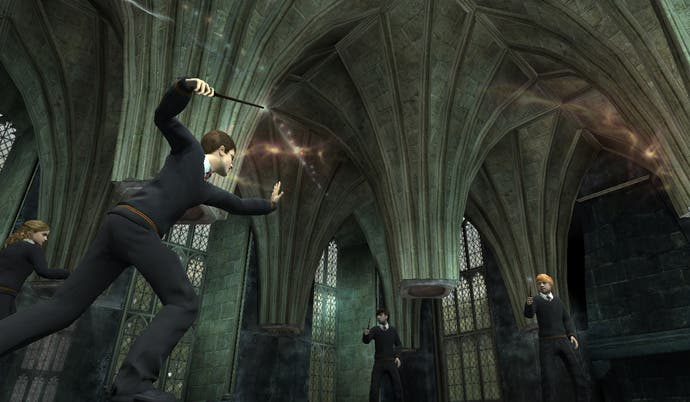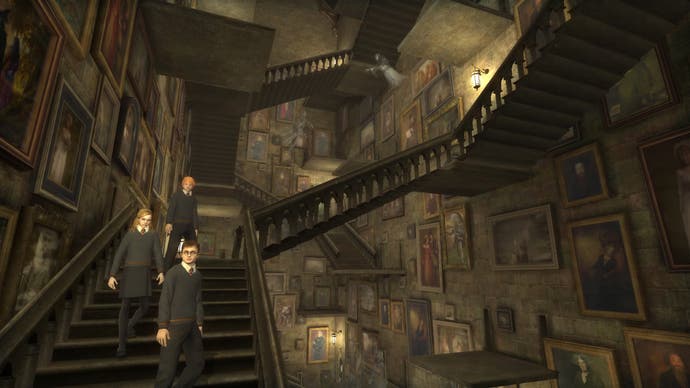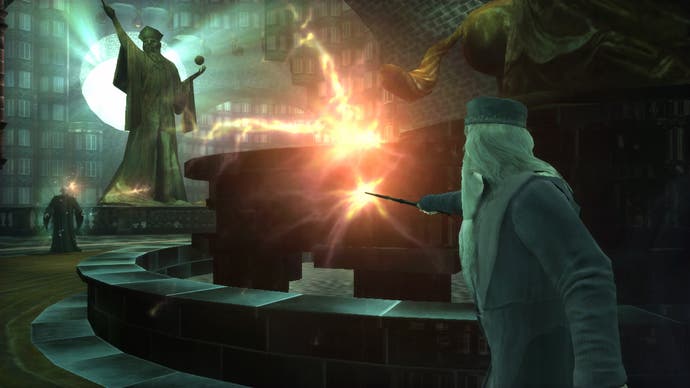Harry Potter and the Order of the Phoenix
Perish in flames?
As Potter fans around the world prepare for the Deathly Hallows' release next month, what better time to, er, play the game of the one before last? The point here, of course, is to keep step with the films, not the books - and so with Order of the Phoenix set to apparate down to the multiplex on 13th July, the timing is actually quite right. Can EA's latest capture the magic of the magic?
Where better to start with the answer to that question than in spellcasting itself - and the Order of the Phoenix initially seems an order of magnitude better off than before. The Wii and PS3 versions use motion-sensors, but where it's available the right-analogue-stick option is more precise, acting as a fairly natural interface between your thumb and the swirls and jabs of the on-screen cast. A simple range of motions takes care of all the important stuff: rotate left for reducto (smash things up), right for reparo (repair them); jab twice forward for depulso (push) and twice back for accio (pull). There are only a couple more to remember, but spellcasting is context-sensitive, so the scale of your options actually expands to fit duelling as well as housekeeping.
The same is also true of Hogwarts itself - quite possibly Potter 5's greatest asset. This time the entire castle's at your disposal, and EA's own brand of technical magic means you'll never encounter a load-screen as you trot past the Fat Lady and out of the Griffyndor common room, descend the stairs to the dungeons, pop down to Hagrid's cabin, head over to the boat-house and take in the gorgeous countryside, or even pop up to the owl-house for a snog with Cho. Challengeverythingo!

Many elements of the book and film have been moulded into action-adventure mechanics. The Marauder's Map always sounded a bit like a videogame map anyway, with its ability to track the movements of your friends and foes, and so it proves here, but EA goes further by running a trail of footsteps ahead of your own so you can work out where you're going without constantly hitting the map button. It's a GTA-style plot arrow by any other description, but it slots neatly into the Potter world. Elsewhere the Invisibility Cloak enables stealth, as you, Hermione and Ron crowd under it and show up to the player as a prismic distortion; a sort of magical Vaseline smear running around the castle evading prefects and Slytherin.
The characters themselves have been brought to life through a mixture of full head-scans and extensive voice sessions. In one of the unlockable "making of" vids (guarded by Moaning Myrtle in the Room of Records, incidentally), fanciable Tonks actress Natalia Tena explains that they recorded each bit of disposable dialogue thrice to avoid repetition. Not staggering, exactly, but good enough, and while there's an initial stiffness to certain exchanges there's quite a lot to applaud too, with difficult bits like the blossoming relationship between Potter and Cho handled delicately enough by Dan Radcliffe and Katie Leung. Graphically they all give the impression of slightly crap enchanted waxworks thanks to mouths and eyes that move sunk into faces that don't, but you can look past it. And hey, some of the people you encounter are dead.

Sadly it's harder to look past the faults in a lot of what you do around Hogwarts. Perhaps the symbiotic good versus evil riff of Potter and Voldemort has wound the sentient castle up into a fit of emulative mischief, but more likely the game's biggest fault is a necessary evil: with such a brilliantly huge and detailed castle to explore, you spend most of the game simply running between people and locations. And this is very boring. The journey, initially, seems to justify it, but by the seventh or eighth time you've climbed the moving staircases to the seventh floor you'll have spoken to most of the portraits - Hoovering up most of the best content in the process - and what charm the experience had is gone.
EA has tried to pad things out by breaking pots, dumping portraits on the floor, covering things in cobwebs and scattering leaves around, but while each represents a chance to bank a bit more experience and potentially level up, none is challenging, there are only a handful of varieties, and "cleaning" doesn't seem like the bit Rowling was trying to emphasise. There are some mini-games too, like Exploding Snap and Wizard Chess, and they relieve the tedium a bit. Not a "more points on the score" bit, but a bit.

Nothing you do when you get to where you're going is ever that compelling either, and there's an uncomfortable cynicism about some of the task design. You enter the library and there are four bookshelves, with the book you need resting atop the one on the far left. You levitate a desk to the foot of the unit and climb onto it and the book flaps its way to the next bookshelf over. Each time you approach, it flaps to the next. The same model's used a few minutes later when you need to grab an owl, except it moves between about a dozen points. Other missions are home to daft quirks, like one about lifting boxes into two identical boats that lie side by side, which only advances when you put the boxes into the boats in a particular sequence that isn't explained.
On top of all this are the niggly faults: the Marauder footsteps sometimes put you into a spin (and who wants to spend the whole game looking at the floor anyway?); character models sometimes warp across the screen in cut-scenes, or get lodged into the scenery; and the camera's under the game's control for the most part, so there are times when positioning yourself to wave your wand is the more difficult than what you're trying to do. Given that it's a game about Dumbledore's Army, the almost complete lack of duels (and the weakness of them at that) is another Dark Mark.
Setting that stuff aside, the broader fault is simply that by the time you've spent an hour in Potter's company, you'll have sussed out the rest of the game, leaving you with even less to look forward to than usual - because of course you know what's going to happen to everyone anyway. If you don't, you're better off reading the book. Or watching the film, probably. By the time I'd reached the Room of Requirement, the most fun left to me was giggling at how Colin Creevey looks a bit like Ian Beale off Eastenders, and when that's what you've been forced to classify as fun, you know the magic is gone.

